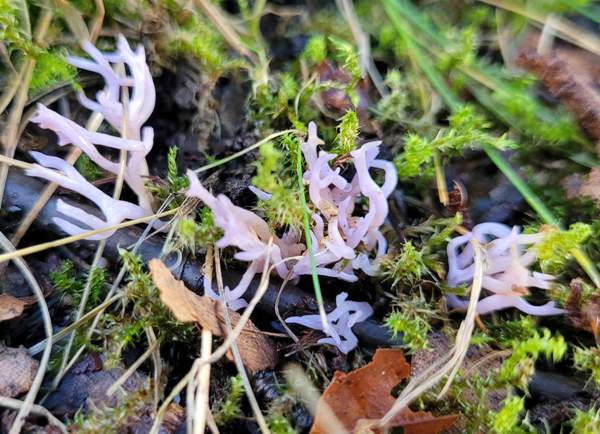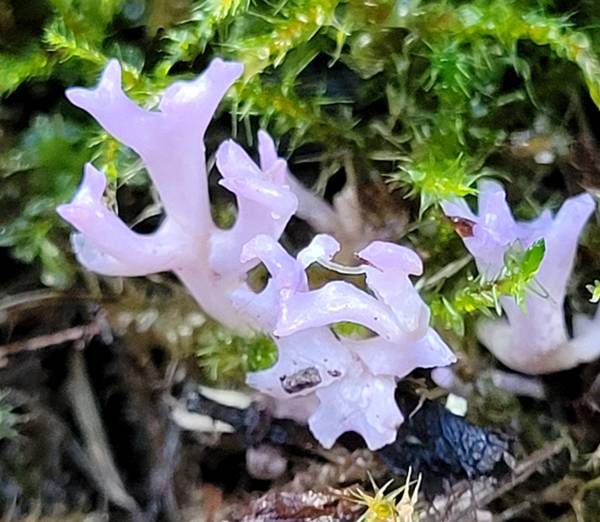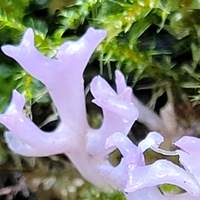Trees Birds Mammals Fish Amphibians Reptiles
Wild Algarve
Bookshop
Ramariopsis pulchella (Fr.) Corner - Lilac Coral
Phylum: Basidiomycota - Class: Agaricomycetes - Order: Clavariales - Family: Clavariaceae
Distribution - Taxonomic History - Etymology - Identification - Culinary Notes - Reference Sources

This small, branching coral fungus is noit often recorded in Britain, largely because if its relative rarity but also it small stature, often being concealed among mosses and leaf litter..

Distribution
Although quite widely distributed in alkaline areas, Lilac Coral is an infrequent to rare find in Britain and Ireland.
Lilac Coral Ramariopsis pulchella is also found in many other temperate parts of mainland Europe and Asia, and this species is known to occur also in North America.
Taxonomic history
Some club-like and coral-like fungi are ascomycetous, but fairy clubs of Ramariopsis and related genera belong to the Basidiomycota.
Ramariopsis pulchella was was originally described in 1887 by French mycologist Jean Louis Émile Boudier, who gave it the scientific name Clavaria pulchella. The currently-accepted scientific name Ramariopsis pulchella dates from a 1950 publication by English mycologist Edred John Henry Corner (1906 - 1996).
Synonyms of Ramariopsis pulchella include Clavaria pulchella Boud., Clavaria tenuissima Sacc., and Ramaria pulchella (Boud.) Quél.
Etymology
The generic name Ramariopsis means resembling Ramaria, while the specific epithet pulchella means 'beautiful little'. This certainly is a beautiful little coral fungus!
Identification guide
 |
Description
Arising from a downy or felted whitish central stem and usually branching frequently, the fruitbody is typically 2 to 4cm tall. Upper surfaces are smooth, lilac or violaceous, and noticeably elastic. |
| |
Spores
Subglobose, finely warty, 3.5-5.0 x 2.5-3.5µm.
Spore print
White. |
Odour/taste |
No noticeable odour; taste mild but not distinctive. |
Habitat & Ecological role |
Saprobic, on soil among leaf litter and mosses in deciduous woodland on calcareous soil. |
Season |
Summer and autumn. |
Similar species |
Ramariopsis subtilis is more slender and has smaller, less warty (sometimes smooth) subspherical or spherical spores.
Clavaria fragilis has white unbranching spindly fruitbodies. |
Culinary Notes
Ramariopsis pulchella is rare and should not be gathered except for scientific study.
Reference Sources
Fascinated by Fungi, 2nd Edition, Pat O'Reilly 2016, reprinted by Coch-y-bonddu Books in 2022.
Mushrooms and Toadstools of Britain and Europe, Vol 1, 2017; G Kibby; ISBN 978-1-9998857-0-0
Dictionary of the Fungi; Paul M. Kirk, Paul F. Cannon, David W. Minter and J. A. Stalpers; CABI, 2008
Taxonomic history and synonym information on these pages is drawn from many sources but in particular from the British Mycological Society's GB Checklist of Fungi.
Acknowledgements
This page includes pictures kindly contributed by Adam Trodd.
Top of page...
Fascinated by Fungi. Back by popular demand, Pat O'Reilly's best-selling 450-page hardback book is available now. The latest second edition was republished with a sparkling new cover design in September 2022 by Coch-y-Bonddu Books. Full details and copies are available from the publisher's online bookshop...